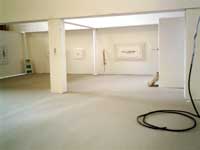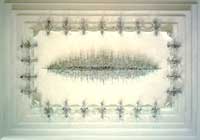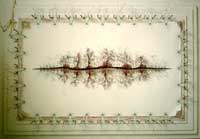Selected Solo Exhibitions
2002 Cathy de Monchaux At Home, Dominc Berning, London
Wetherspoon Gallery, Greensboro, USA
2000 Hiroshorn Museum, Washington D.C
Albright Knox Art Gallery, Buffalo, New York
1999 Sean Kelly Gallery, New York
Mitchell Innes and Nash Gallery, New York
1997 Whitechapel Art Gallery, London
1996 Sean Kelly Gallery, New York
1994 Arnol Fini, Bristol
Jennifer Flay Gallery, Paris
1993 Chisenhale Gallery, London
Center For Contemporary Art, Glasgow
Selected Group Exhibitions
2002 Material Matters, Norrkopings Museum, Sweden.
2001 Votive, British Council tour, New Zealand
Sacred and Profane, Arts Council of Great Britain. Touring exhibition.
2000 Sean Kelly, New York
1998 Wounds Between Democracy and Redemption In Contemporary Art, Moderna Museet, Stockholm
Turner Prize, Tate Gallery, London
Material Culture, Hayward Gallery, London
1996 Sala Moncada De La Fundacion La Caixa, Barcelona
1995 Feminin-Masculin, Centre Georges Pompidou, Paris
ART 95, Museum of Contemporary Art, Helsinki
1994 The Day After Tomorrow, Belem Museum, Lisbon
Bienalle of Sao Paolo, Brazil
1993 In Site - New British Sculpture, Museet For Sandiskunst, Oslo
Prospect 93, Frankfurter Kunstverein, Frankfurt
1992 Bienalle of Sydney, Australia
Cathy de Monchaux¹s artistic language has always been rife with paradox. Immediate, distinctive and utterly particular to her; it is both sharply-focused and wide-reaching, extending way beyond issues of style to permeate all manner of media from photographed landscape to recorded sound as well as the intricately-wrought floor and wall pieces for which she is best known. A peculiar parallel universe is conjured up, redolent with mystery and yet instantly communicable, where forms, images and objects are both disquietingly familiar as well as being impossible to identify. Wrong-footing is rife: what appears to be one thing mutates into something altogether different, and just when you think you¹ve got a handle on that, it becomes something else yet again.
The most recent work is especially elusive. Drawings, sculpture, photographs and found objects combine, coalesce and assume new lives of their own. Free from category or definition, these complex hybrids hang or prop themselves against walls or in corners, uniting to create an environment in which culture and nature go into mutual melt down. Yet, amidst all this fluidity and metamorphing, there has also been a definite shift in mood. A fragile calm has descended. The atmosphere remains uneasy but held in check. De Monchaux¹s modus operandi continues to be meticulous and intricate but it is now less frenetic: ornament has been reined-in; dusty white and cool verdigris combine to chill out the more livid flesh tones and boundaries are blurred out by frizzy whorls of wire. Although sexual imagery still seethes and simmers beneath the surface, it is not so outrageously, viscerally genital, no longer so eager to bare all.
Which is not to say that the intensity has abated, more that the focus has changed. It¹s almost as if, by honing her vocabulary, De Monchaux is allowing some air into her psychodramas. Her new series, collectively titled "Mise en Scene" houses disparate objects in such a way that the focus is on the site of the drama and not, as in the past, the containers themselves. These odd pieces of found and fabricated flotsam may not be as elaborately-wrought as previous votive pieces, but they are just as obsessively-orchestrated. Trapped behind glass they function as propositions, snatches of poetry or music - immortalising and monumentalising the insignificant and opening it up to all of us. Louisa Buck
Proposal for a collaborative project at the Damien B. Art Center project's room for Art Basel 2003
Cathy de Monchaux, Artist
Martyn Ware, Musician
Vince Clarke, Musician
Theodore Zeldin, Philosopher
The artist Cathy de Monchaux could be seen as something of a Maverick in the art world. Part shaman, part sculptor, she makes objects which defy categorisation. She has exhibited extensively around the world in galleries and museums. Her work is held in many public and private collections. In1998 she was short-listed for the Turner Prize for her solo show at The Whitechapel Art Gallery in London where she lives. She is represented by Sean Kelly Gallery in New York.
Martyn Ware and Vince Clarke are highly regarded and respected in the Music Industry. Initially with the bands Heaven 17, Human League and Erasure, they have branched out over the years to other prestigious projects such as producing albums for Tina Turner and Terence Trent d¹Arby as well as writing scores for film, TV, theatre and radio. They were introduced to Cathy de Monchaux when they were looking for artists to collaborate with using their unique "Heightened Reality" 3-D surround sound technology.
The world renound philosopher and Historian Theodore Zeldin wrote such books as an Intimate History of Humanity and The French. He figures on the magazine Littéraire's list of the hundred most important thinkers in the world today and has virtual guru status in many peoples eyes. He came across Cathy de Monchaux's work at the Hirshorn Museum in Washington and felt compelled to contact her to see if they could work on a project together.
The space could be a white cube or a palazzo, a factory or the back of a container lorry. Its form will decide the interventions needed to change its mood and create an atmosphere of contemplation.
The aim is to encourage the viewer to alter their state as they enter the room. That a fusion of thinking will occur between the objects and sounds and the contents of the viewers minds eye. We don¹t want to force feed thinking we want to liberate thoughts.
The space will be somewhere to sit, to spend time. It is a place to be in the fullest sense.
Cathy de Monchaux's practice is based on using herself as the initial subject of her work while at the same time generating a language and a form for it that allows her objects to stand alone from her as their creator.
Her aim is to invent abstract objects that somehow invite in the viewer a gut reaction which impinges on their personal inner psychology.
Thus the self portrait of her internal psyche becomes, on some levels, a mirror for the thoughts of many of her viewers which they can recognise and relate to on an intimate level.
It was this sense of recognition that Theodore Zeldin felt when he saw her work and compelled him to contact her. One strand of Zeldin's work for many years has been to examine the notion of the individual human portrait in written terms as a means to understand the history and the future of the world and humanity as a whole.
Since meeting they have been discussing ways to make visible through physical objects the ideas that they share and debates that they have about various human types that they feel could make up a portrait of the world.
Taking as subjects everything from Firemen to Politicians, the Shamen to the western guru, the housewife to the director of a multinational corporation they are attempting to begin to define a history of the human future. By examining the underlying psychological impulses of the human animal as they find it in the twenty first century.
The provocation for both artist and philosopher is to unravel their singular visions and allow new impulses thoughts and ideas to enter their practices. The aim is to arrive at objects which embrace and hold up a mirror to these many human psyche¹s in a way that wouldn¹t be possible if they were working alone.
The sound occupies the space in a three dimensional way. Therefore you can layer different elements such as voice and music to exist simultaneously in the space. In this installation the sound will operate on two levels.
Firstly as the spoken word. The technology is so subtle that it can allow thoughts and ideas to be whispered in the viewers ear as they move around the space. The words and phrases used will be the product of the collaborative process. The aim is to prompt a more comprehensive view of the objects that de Monchaux will make.
Secondly Clarke and Ware will create an underlying musical score which will enhance the experience of the viewer as they occupy the space and gaze at the objects.
The objective is to produce a soundtrack which emphasizes the subject types and emotional range that we are trying to depict.
Due to the three dimensionality of the sound we can alter the tempo and feel of the aural emotive experience so that the viewers mood changes as they move around the space and encounter different objects.
Unlike the way that a film score operates emotively in linear time, this score can incite a range of sensibilities simultaneously in real time.
|


